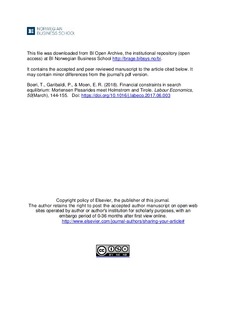Financial constraints in search equilibrium: Mortensen Pissarides meet Holmstrom and Tirole
Journal article, Peer reviewed
Accepted version
Date
2018Metadata
Show full item recordCollections
- Publikasjoner fra CRIStin - BI [1015]
- Scientific articles [2173]
Original version
Labour Economics. 2018, 50(March), 144-155. https://doi.org/10.1016/j.labeco.2017.06.003Abstract
A key lesson from the Great Recession is that firms’ leverage and access to finance are important for hiring and firing decisions. It is now empirically established that bank lending is correlated with employment losses when credit conditions deteriorate. We provide further evidence of this and make causal inferences on the effect of leverage on job losses drawing on a new firm-level dataset that we assembled on employment and financial positions of European firms. Yet, in the Diamond Mortensen Pissarides (DMP) model there is no role for finance. All projects that display positive net present values are realized and financial markets are assumed to be perfect. What if financial markets are not perfect? Does a different access to finance influence the firm’s hiring and firing decisions? The paper uses the concept of limited pledgeability proposed by Holmstrom and Tirole to integrate financial imperfections and labor market imperfections. A negative shock wipes out the firm’s physical capital and leads to job destruction unless internal cash was accumulated by firms. If firms hold liquid assets they may thus protect their search capital, defined as the cost of attracting and hiring workers. The paper explores the trade-off between size and precautionary cash holdings in both partial and general equilibrium. We find that if labor market frictions disappear, so does the motive for firms to hold liquidity. This suggests a fundamental complementarity between labor market frictions and holding of liquid assets by firms.
